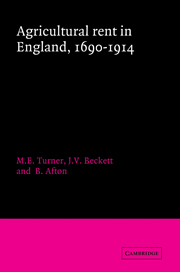Book contents
- Frontmatter
- Contents
- List of figures
- List of tables
- Preface
- Note on the text
- List of abbreviations
- Two examples of contemporary rent books
- Introduction
- 1 Agricultural rent in England
- 2 Contemporary views of rent in eighteenth and nineteenth-century England
- 3 The current state of knowledge
- 4 The determining parameters of a rent index
- 5 Constructing the rent index I: estate records
- 6 Constructing the rent index II: government inquiries
- 7 Constructing the rent index III: other studies
- 8 An English agricultural rent index, 1690–1914
- 9 Rent arrears and regional variations
- 10 The rent index and agricultural history I: the long term
- 11 The rent index and agricultural history II: the short term
- Conclusion
- Appendix 1 Sources of the rent index
- Appendix 2 Statistical summary
- Bibliography
- Index
11 - The rent index and agricultural history II: the short term
Published online by Cambridge University Press: 02 December 2009
- Frontmatter
- Contents
- List of figures
- List of tables
- Preface
- Note on the text
- List of abbreviations
- Two examples of contemporary rent books
- Introduction
- 1 Agricultural rent in England
- 2 Contemporary views of rent in eighteenth and nineteenth-century England
- 3 The current state of knowledge
- 4 The determining parameters of a rent index
- 5 Constructing the rent index I: estate records
- 6 Constructing the rent index II: government inquiries
- 7 Constructing the rent index III: other studies
- 8 An English agricultural rent index, 1690–1914
- 9 Rent arrears and regional variations
- 10 The rent index and agricultural history I: the long term
- 11 The rent index and agricultural history II: the short term
- Conclusion
- Appendix 1 Sources of the rent index
- Appendix 2 Statistical summary
- Bibliography
- Index
Summary
Most historians would agree that between the seventeenth and the nineteenth centuries considerable changes took place in English agriculture. Critically, a major increase in output and productivity ensured that although some food had to be imported, for most of the period a growing and increasingly urbanised and industrialised population was fed from home production. Until about 1760 Britain was essentially a net exporter of grain, but the trend gradually moved in the opposite direction until the normal position that was assumed – and has been the case until very recent times – was that Britain became a net importer of grain. Even so, by 1850 an estimated 6.5 million extra mouths were being fed from home production compared with 1750. By 1868 perhaps still as much as 80 per cent of UK food was home produced. By 1914, however, perhaps only one-half was home produced. For the purpose of further discussion, and to place the rent index within the context of the changes that took place in agriculture, we have divided the period 1690–1914 into convenient time frames, largely reflecting accepted movements in the pattern of farming through the whole period.
1690–1750: agricultural depression or no agricultural depression?
The survival of rent material only comes on stream to any significant extent after 1690, and then as chapter 8 has shown it begins rather slowly. But as we parachute into this last decade of the seventeenth century what understanding of agricultural rents do we bring with us? From the completed researches of individual landed families we can say that in the two decades since the Restoration in 1660 there had been a severe decline in rents, subsequently followed by some indications of a recovery.
- Type
- Chapter
- Information
- Agricultural Rent in England, 1690–1914 , pp. 225 - 252Publisher: Cambridge University PressPrint publication year: 1997



